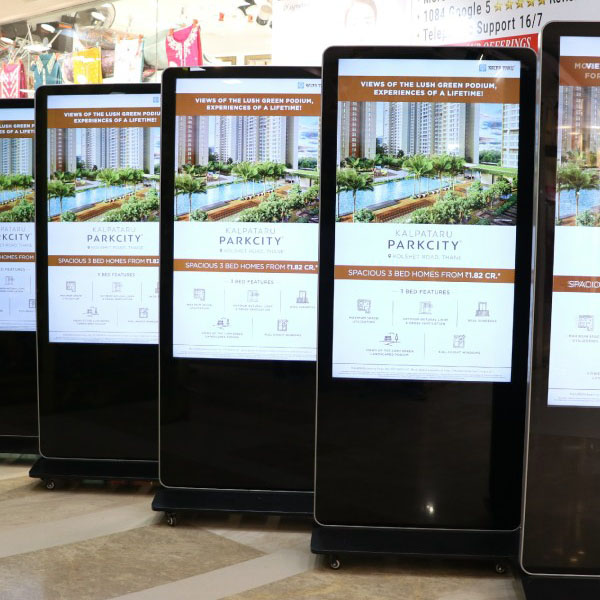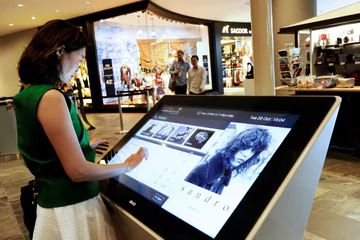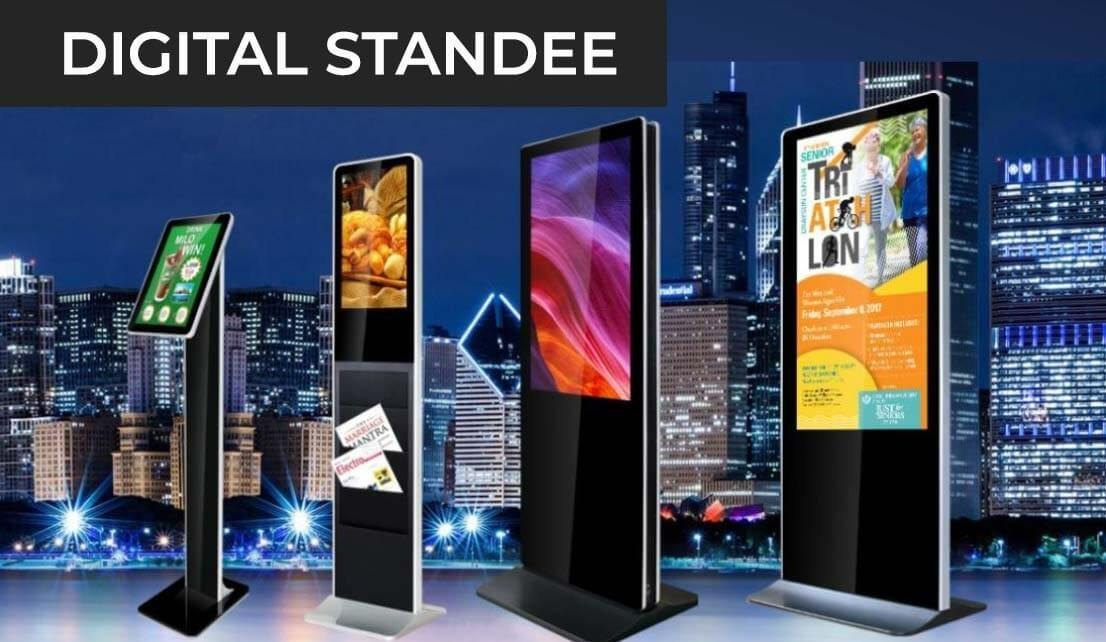In an era where information is at our fingertips, and visual communication dominates the digital landscape, businesses are constantly seeking innovative ways to engage and captivate their audience. One such innovation is the utilization of K-Type digital signage. This comprehensive 2000-word blog explores the world of K-Type digital signage, shedding light on its significance, applications, benefits, and the technology that makes it all possible.
Table of Contents:
- Introduction
- Understanding K-Type Digital Signage
- The Technology behind K-Type Digital Signage
- Applications Across Various Industries
- Benefits and Advantages
- Design and Content Creation
- Installation and Maintenance
- Interactive K-Type Digital Signage
- Measuring Success: Analytics and ROI
- Future Trends in K-Type Digital Signage
- Conclusion
1. Introduction
In today’s fast-paced and hyper-connected world, grabbing the attention of consumers and conveying information effectively is paramount for businesses. Traditional static signage and printed advertisements are no longer sufficient to engage and inform. This is where digital signage, and more specifically, K-Type digital signage, comes into play.
K-Type digital signage represents a significant leap in the evolution of digital displays. It offers vibrant visuals, engaging content, and interactive capabilities that capture the imagination of audiences in a way that traditional media cannot. This blog delves deep into the world of K-Type digital signage, exploring its technology, applications, benefits, and the future it promises.
2. Understanding K-Type Digital Signage
K-type digital signage refers to a class of digital displays characterized by their use of organic light-emitting diode (OLED) technology. Unlike traditional LED or LCD screens, OLED displays do not require a backlight. Instead, each pixel generates its own light, allowing for individually lit and controlled pixels. This results in vibrant colors, high contrast ratios, and remarkable flexibility in design.
The “K-Type” in K-Type digital signage stands for “Knowledge-Type,” reflecting the vast amount of information and data that can be displayed and interacted with on these screens. These screens can be found in various forms, including curved displays, transparent screens, and flexible screens that can be bent or rolled, enabling unique and eye-catching installations.
3. The Technology behind K-Type Digital Signage
K-Type digital signage’s technological core lies in the use of organic light-emitting diodes (OLEDs). OLEDs are composed of organic compounds that emit light when an electric current is applied. Here are some key technological aspects of K-Type digital signage:
- Pixel-Level Control: OLEDs allow each pixel to emit light independently. This results in true blacks, vibrant colors, and high contrast ratios, as dark pixels simply remain turned off.
- Flexibility: OLED displays can be flexible and thin, which means they can be used in curved or unconventional forms, expanding the possibilities for creative installations.
- Energy Efficiency: OLED technology is more energy-efficient compared to traditional LED or LCD displays, making it a sustainable choice.
- Transparency: Some K-Type digital signage solutions are transparent when turned off, allowing for innovative see-through installations.
- Durability: OLED displays are known for their long lifespan and resistance to burn-in, which can be a concern with traditional LED displays.
4. Applications across Various Industries
The versatility of K-Type digital signage makes it suitable for a wide range of industries. Here are some notable applications:
a. Retail
In the retail sector, K-Type digital signage can serve various purposes, from engaging window displays to interactive in-store product presentations. Retailers can use flexible OLED screens to create captivating and immersive shopping experiences.
b. Hospitality
Hotels and restaurants can utilize K-type digital signage for interactive menus, wayfinding, and guest engagement. Transparent OLED screens can be integrated into partitions and windows, offering a unique touch of modernity.
c. Healthcare
In healthcare, K-type digital signage can provide real-time information, wayfinding assistance, and interactive patient education. The high contrast and clarity of OLED screens are valuable for medical imaging and diagnostics.
d. Transportation
Airports, train stations, and bus terminals can benefit from OLED digital signage for displaying flight and departure information, as well as dynamic advertising. The flexibility of OLED screens allows for curved displays in transport hubs.
e. Entertainment
K-Type digital signage can transform the entertainment industry with immersive experiences in cinemas, theaters, and concert venues. Curved OLED screens can envelop the audience, enhancing visual experiences.
f. Corporate
Corporations can use OLED signage for dynamic presentations, interactive boardrooms, and innovative office spaces. Transparent OLED screens can be used for collaborative workspaces.
g. Education
In educational institutions, K-type digital signage can offer interactive learning experiences and wayfinding assistance. Transparent OLED displays can be integrated into classrooms and libraries.
5. Benefits and Advantages
The adoption of K-type digital signage offers a multitude of benefits and advantages for businesses. Here are some of the key advantages:
a. Visual Impact
K-Type digital signage delivers stunning visual impact with vibrant colors, true blacks, and high contrast ratios. It captures and retains the attention of viewers effectively.
b. Flexibility in Design
The flexibility of OLED displays allows for creative and unconventional designs. Businesses can explore unique installations that are not possible with traditional LED or LCD screens.
c. Energy Efficiency
OLED technology is energy-efficient, which can lead to cost savings over time. Additionally, it is more environmentally friendly compared to other display technologies.
d. Durability
OLED displays have a long lifespan and are resistant to burn-in, ensuring that the signage remains reliable over extended periods of use.
e. Transparency
Some K-Type digital signage solutions offer transparency when turned off. This feature can be leveraged for innovative see-through installations, combining physical and digital elements.
f. Interactive Capabilities
Many K-type digital signage solutions support interactive touch functionality, enabling user engagement and participation. This is particularly valuable for sectors like retail and education.
6. Design and Content Creation
The success of K-Type digital signage depends not only on the technology but also on the design and content displayed. Designing effective content for these displays requires a deep understanding of the medium. Here are some design considerations:
a. Content Relevance
Content should be relevant to the location and audience. In retail, for example, dynamic product displays and promotions are effective, while in healthcare, informative and empathetic content is key.
b. Visual Appeal
Leverage the vibrant colors and contrast of K-Type digital signage to create visually appealing content. High-resolution images and videos can showcase products or convey messages effectively.
c. Interactivity
Utilize the interactive capabilities of these displays by incorporating touch elements. Interactive content can engage viewers and provide them with a memorable experience.
d. Dynamic Messaging
One of the advantages of digital signage is the ability to change content on the fly. Utilize this feature to display real-time information, promotions, and event updates.
7. Installation and Maintenance
Proper installation and maintenance are crucial for ensuring the longevity and effectiveness of K-Type digital signage. Here are some considerations:
a. Professional Installation
Engage professionals in the installation of OLED displays to ensure they are securely mounted and correctly calibrated.
b. Content Management
Implement a robust content management system (CMS) to schedule and update content easily. This allows for timely promotions and information updates.
c. Regular Inspections
Perform routine inspections and maintenance to address any technical issues promptly. OLED displays are durable but still require care.
d. Firmware Updates
Keep the display’s firmware up to date to benefit from software enhancements and security updates.
8. Interactive K-Type Digital Signage
Interactive K-type digital signage takes engagement to the next level. These displays allow users to interact directly with the content, making it a two-way communication channel. Common interactive features include touchscreens, gesture recognition, and even facial recognition for personalization.
Examples of interactive K-Type digital signage applications include virtual product catalogs with touchable interfaces in retail stores, wayfinding kiosks with touchscreen maps in public spaces, and educational displays that encourage hands-on learning.
9. Measuring Success: Analytics and ROI
To determine the effectiveness of K-Type digital signage, businesses can employ analytics and metrics. These tools help in measuring return on investment (ROI) and making data-driven decisions. Key performance indicators (KPIs) to consider include:
- Audience Engagement: Analyze the level of interactivity and engagement with the signage. Track the number of touches or interactions over time.
- Dwell Time: Measure how long viewers spend engaging with the content. Longer dwell times often indicate the effectiveness of the display.
- Conversion Rate: In retail, track how many interactions with the signage lead to a purchase. This can provide valuable ROI insights.
- Content Popularity: Determine which content is most popular and effective. Use A/B testing to optimize content strategies.
- Foot Traffic: In transportation and retail, monitor foot traffic around the display. Analyze how the signage affects the flow of people.
10. Future Trends in K-Type Digital Signage
As technology continues to advance, K-Type digital signage is expected to evolve and offer even more exciting possibilities. Here are some future trends to watch out for:
a. Augmented Reality Integration
The integration of augmented reality (AR) into K-type digital signage is expected to create immersive and interactive experiences. Users will be able to interact with virtual elements in the real world through OLED displays.
b. AI-Driven Personalization
Artificial intelligence (AI) will play a significant role in personalizing content based on user preferences and behavior. This will result in more relevant and engaging displays.
c. Enhanced Transparency
Developments in OLED technology are likely to lead to even more transparent displays, opening up new opportunities for integrating signage seamlessly into physical environments.
d. Sustainability Focus
Businesses and consumers are increasingly conscious of environmental impact. OLED technology is already energy-efficient, but future advancements may make it even more sustainable.
e. Integration with IoT
The Internet of Things (IoT) will enable K-Type digital signage to connect with other devices and systems, providing real-time data and enhancing interactivity.
11. Conclusion
K-Type digital signage represents a powerful tool for businesses to engage and inform their audiences. The technology’s impressive visual quality, flexibility, and interactivity offer a wealth of opportunities across various industries. By designing compelling content, ensuring professional installation and maintenance, and measuring success with analytics, businesses can harness the potential of K-Type digital signage to captivate and connect with their audience.
As technology continues to advance, the future of K-Type digital signage promises even more exciting developments. Augmented reality, AI-driven personalization, enhanced transparency, sustainability, and IoT integration are among the trends that will shape the future of this dynamic medium. As businesses and consumers continue to seek innovative and engaging ways to convey and consume information, K-Type digital signage is set to play a pivotal role in the evolution of digital communication.
















